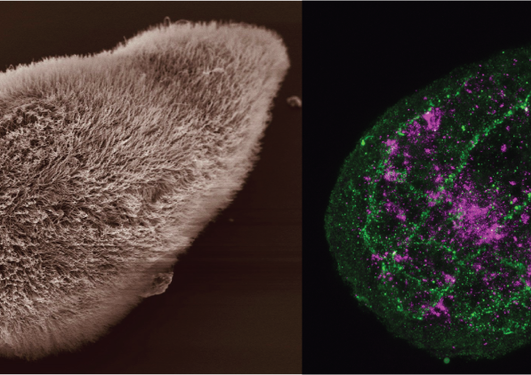Uncovering the intricate interactions of neuropeptides with their receptors
Neuropeptides and their receptors are ubiquitous in animals, but the way they interact with each other is poorly known. In a new article, researchers described the dynamic structure of a FMRFamide receptor and novel tools to predict the function of these proteins in animals.
Main content
In a new article published in Nature Structural and Molecular Biology, authors Valeria Kalienkova, postdoctoral researcher at the Department of Biomedicine, Mowgli Dandamudi, PhD graduate from the Michael Sars Centre, Cristina Paulino, Assistant Professor at the University of Groningen and Timothy Lynagh, group leader at the Michael Sars Centre, have elucidated the structure of a neuropeptide receptor in the spiralian model Malacoceros fuliginosus. Neuropeptides are small proteins that are packaged into vesicles and released from cells in the nervous system. After diffusing to other cells, neuropeptides typically bind to receptors – large proteins on the cell surface that recognize specific signals and alter activity in the cell. Most animals use neuropeptides for signaling from cell to cell, even animals lacking complex nervous systems, and this could constitute a precursor of the more nuanced synaptic signaling adopted by the complex human nervous system.
The tetra-peptide FMRFamide is a common neuropeptide in invertebrates. One of its receptors is the FMRFamide-gated sodium channel (FaNaC), a close cousin of the acid-sensing sodium channels (ASICs) in our nervous system. Previous work lead by Mowgli Dandamudi had shown how the FaNaC family diverged in mollusks and annelid worms to give rise to receptors for various different neuropeptides particularly in annelid worms. The structural basis by which specific chemical signals like neuropeptides, acid, or other chemicals, are recognized by FaNaCs, ASICs, and other receptors, is poorly understood. Similarly, it is unknown how chemical binding triggers conformational changes in the receptor’s channel domain in the cell membrane, leading to the influx of sodium ions into the cell. The team therefore used single particle cryo-electron microscopy, the leading method in imaging cell membrane proteins, to try and capture the structure of a FaNaC from Malacoceros fuliginosus, an annelid worm maintained at the Michael Sars Centre.
“This was very unexpected, but also quite exciting – nature never fails to challenge our pre-set ideas and concepts!”
- Valeria Kalienkova
Since there is no single particle cryo-electron microscope in Norway, the Lynagh lab turned to their collaborators with expertise and facilities. Valeria Kalienkova, at the time a postdoc in the group of Cristina Paulino at the University of Groningen, grew a lot of Malacoceros FaNaC in the laboratory, incorporated millions of FaNaC molecules into their own miniature cell membranes (or “nanodiscs”), and imaged them under the microscope. She did this for FaNaC alone, and for FaNaC in the presence of neuropeptides, and after averaging images of hundreds of thousands of particles, she generated high-resolution 3D maps of FaNaC in resting and active conformations. “I am trained to think that regions of the protein important for the function should have a very conserved structure, and it is absolutely not the case with FaNaCs”, Valeria explained. “This was very unexpected, but also quite exciting – nature never fails to challenge our pre-set ideas and concepts!”
These results raised several biophysical hypotheses on how the receptor binds ligands and conducts sodium ions, which Mowgli was able to test in the Lynagh lab by making mutant versions of the receptors and recording neuropeptide-activated sodium currents through the receptor. “The most exciting find of this study is the very definite answer to the question of "Where does FMRFamide bind on an FMRFamide-gated Sodium Channel"”, Mowgli said. “As a testament to Valeria's skills, that is not the only answer we found. We also learned how partial agonists bind to a FaNaC, and we found out more information on how FMRFamide gates the channel and how it opens.”
In practice, the results of the study will allow researchers to read an animal’s genome and predict what function will be performed by different FaNaC-related genes. Furthermore, the team observed how the binding of signaling molecules triggers conformational changes in a protein of the nervous system, and saw what a sodium-conducting channel looks like in high resolution. These advances will enable future biophysical and pharmacological studies seeking to understand and modulate signaling between cells in the nervous system.




